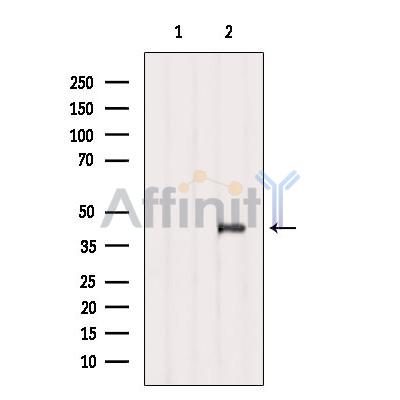SPAG4L Antibody - #DF12478
| Product: | SPAG4L Antibody |
| Catalog: | DF12478 |
| Description: | Rabbit polyclonal antibody to SPAG4L |
| Application: | WB IHC |
| Reactivity: | Human, Mouse, Monkey |
| Prediction: | Pig, Bovine, Horse, Sheep, Rabbit, Dog |
| Mol.Wt.: | 43 kDa; 43kD(Calculated). |
| Uniprot: | Q8TC36 |
| RRID: | AB_2845283 |
Related Downloads
Protocols
Product Info
*The optimal dilutions should be determined by the end user. For optimal experimental results, antibody reuse is not recommended.
*Tips:
WB: For western blot detection of denatured protein samples. IHC: For immunohistochemical detection of paraffin sections (IHC-p) or frozen sections (IHC-f) of tissue samples. IF/ICC: For immunofluorescence detection of cell samples. ELISA(peptide): For ELISA detection of antigenic peptide.
Cite Format: Affinity Biosciences Cat# DF12478, RRID:AB_2845283.
Fold/Unfold
dJ726C3.1; MGC33594; SPAG4-like protein; Sperm associated antigen 4 like protein; SUN domain-containing protein 5; SUN5; SUN5 Sad1 and UNC84 domain containing 5; testis and spermatogenesis related gene 4; Testis and spermatogenesis related gene 4 protein; TSARG4;
Immunogens
A synthesized peptide derived from human SPAG4L, corresponding to a region within the internal amino acids.
Sperm (at protein level) (PubMed:27640305). Widely expressed (PubMed:12621555). Conflictingly shown to be specifically expressed in testis (PubMed:21711156).
- Q8TC36 SUN5_HUMAN:
- Protein BLAST With
- NCBI/
- ExPASy/
- Uniprot
MPRSSRSPGDPGALLEDVAHNPRPRRIAQRGRNTSRMAEDTSPNMNDNILLPVRNNDQALGLTQCMLGCVSWFTCFACSLRTQAQQVLFNTCRCKLLCQKLMEKTGILLLCAFGFWMFSIHLPSKMKVWQDDSINGPLQSLRLYQEKVRHHSGEIQDLRGSMNQLIAKLQEMEAMSDEQKMAQKIMKMIHGDYIEKPDFALKSIGASIDFEHTSVTYNHEKAHSYWNWIQLWNYAQPPDVILEPNVTPGNCWAFEGDRGQVTIQLAQKVYLSNLTLQHIPKTISLSGSLDTAPKDFVIYGMEGSPKEEVFLGAFQFQPENIIQMFPLQNQPARAFSAVKVKISSNWGNPGFTCLYRVRVHGSVAPPREQPHQNPYPKRD
Predictions
Score>80(red) has high confidence and is suggested to be used for WB detection. *The prediction model is mainly based on the alignment of immunogen sequences, the results are for reference only, not as the basis of quality assurance.
High(score>80) Medium(80>score>50) Low(score<50) No confidence
Research Backgrounds
Plays an essential role in anchoring sperm head to the tail. Is responsible for the attachment of the coupling apparatus to the sperm nuclear envelope.
Highly glycosylated in the Golgi apparatus during spermiogenesis.
Nucleus inner membrane>Single-pass membrane protein. Golgi apparatus.
Note: During spermiogenesis, traffics through the Golgi apparatus before reaching the round spermatid inner membrane of the nuclear envelope and later migrates to the coupling apparatus of the sperm during sperm head elongation and differentiation. In mature spermatozoa, is localized to the coupling apparatus of the sperm head and tail in the implementation fossa.
Sperm (at protein level). Widely expressed. Conflictingly shown to be specifically expressed in testis.
Restrictive clause
Affinity Biosciences tests all products strictly. Citations are provided as a resource for additional applications that have not been validated by Affinity Biosciences. Please choose the appropriate format for each application and consult Materials and Methods sections for additional details about the use of any product in these publications.
For Research Use Only.
Not for use in diagnostic or therapeutic procedures. Not for resale. Not for distribution without written consent. Affinity Biosciences will not be held responsible for patent infringement or other violations that may occur with the use of our products. Affinity Biosciences, Affinity Biosciences Logo and all other trademarks are the property of Affinity Biosciences LTD.


